1.初识RabbitMQ
1.1.同步调用
我们现在基于
OpenFeign的调用都属于是同步调用,那么这种方式存在哪些问题呢?
- 拓展性差
- 性能下降
- 级联失败
而要解决这些问题,我们就必须用异步调用的方式来代替同步调用。
1.2.异步调用
异步调用方式其实就是基于消息通知的方式,一般包含三个角色:
消息发送者:投递消息的人,就是原来的调用方消息Broker:管理、暂存、转发消息,你可以把它理解成微信服务器消息接收者:接收和处理消息的人,就是原来的服务提供方

在异步调用中,发送者不再直接同步调用接收者的业务接口,而是发送一条消息投递给消息Broker。然后接收者根据自己的需求从消息Broker那里订阅消息。每当发送方发送消息后,接受者都能获取消息并处理。这样,发送消息的人和接收消息的人就完全解耦了。
异步调用的优势包括:
- 耦合度更低
- 性能更好
- 业务拓展性强
- 故障隔离,避免级联失败
当然,异步通信也并非完美无缺,它存在下列缺点:
- 完全依赖于Broker的可靠性、安全性和性能
- 架构复杂,后期维护和调试麻烦
2.RabbitMQ
RabbitMQ是基于Erlang语言开发的开源消息通信中间件,官网地址:
Messaging that just works — RabbitMQ
2.1.安装
我们同样基于Docker来安装RabbitMQ,使用下面的命令即可:
docker run \
-e RABBITMQ_DEFAULT_USER=liming \
-e RABBITMQ_DEFAULT_PASS=123321 \
-v mq-plugins:/plugins \
--name mq \
--hostname mq \
-p 15672:15672 \
-p 5672:5672 \
--network liming \
-d \
rabbitmq:3.8-management
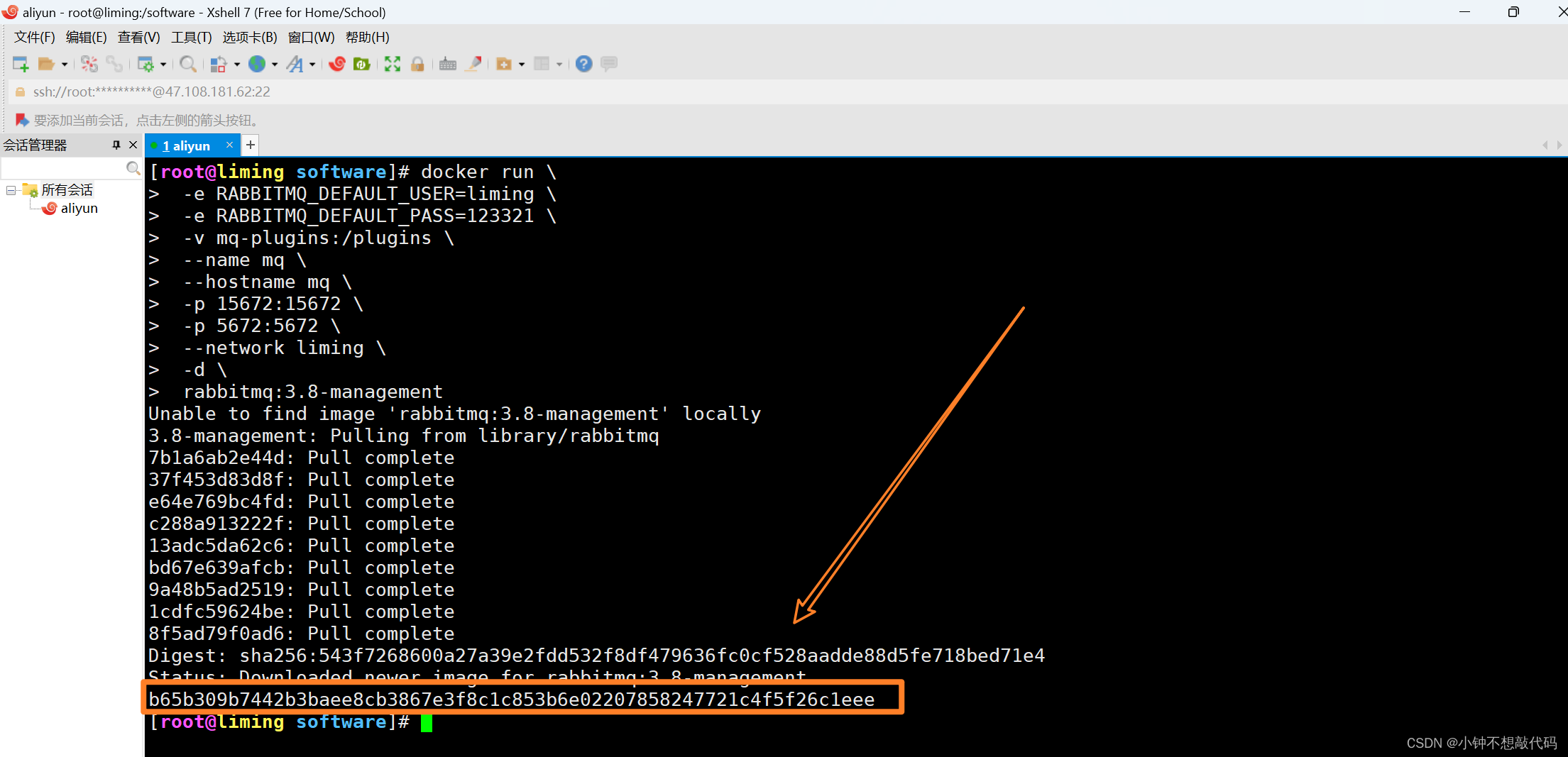
可以看到在安装命令中有两个映射的端口:
15672:RabbitMQ提供的管理控制台的端口5672:RabbitMQ的消息发送处理接口
安装完成后,我们访问 http://ip:15672即可看到管理控制台。首次访问需要登录,默认的用户名和密码在配置文件中已经指定了。
登录后即可看到管理控制台总览页面:
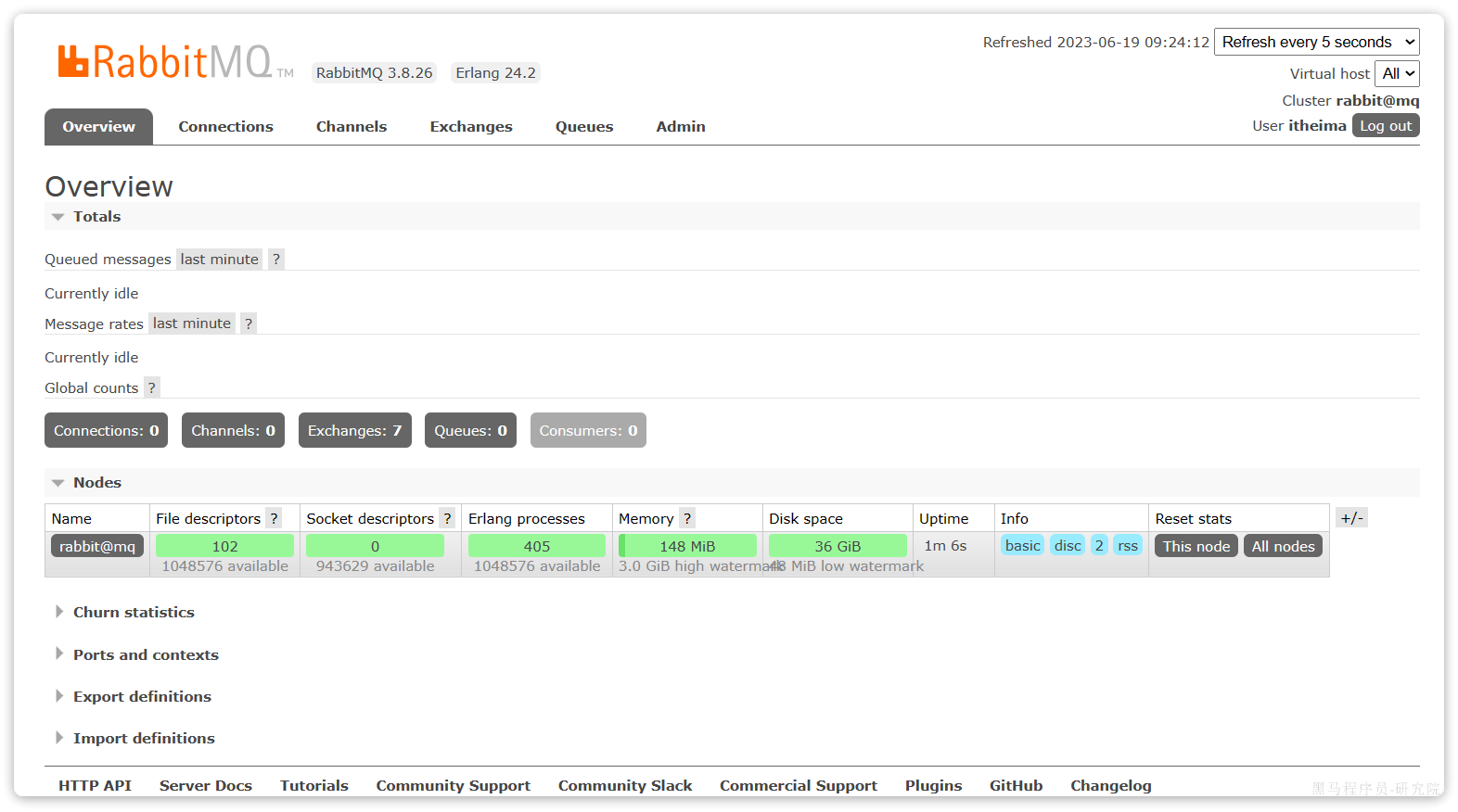
RabbitMQ对应的架构如图:

其中包含几个概念:
publisher:生产者,也就是发送消息的一方consumer:消费者,也就是消费消息的一方queue:队列,存储消息。生产者投递的消息会暂存在消息队列中,等待消费者处理exchange:交换机,负责消息路由。生产者发送的消息由交换机决定投递到哪个队列。virtual host:虚拟主机,起到数据隔离的作用。每个虚拟主机相互独立,有各自的exchange、queue
2.2.收发消息
2.2.1.交换机
我们打开Exchanges选项卡,可以看到已经存在很多交换机:

我们点击任意交换机,即可进入交换机详情页面。仍然会利用控制台中的publish message 发送一条消息:
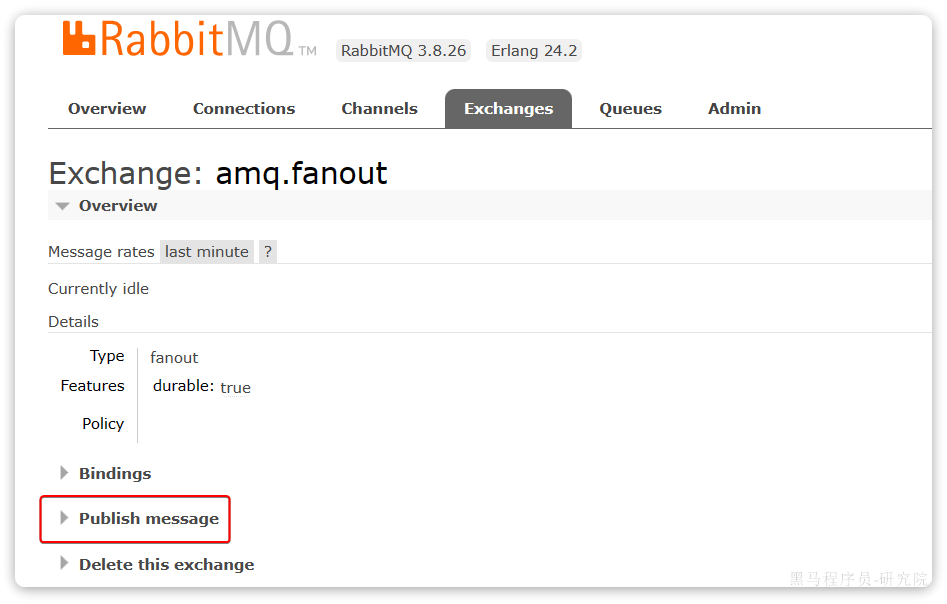

这里是由控制台模拟了生产者发送的消息。由于没有消费者存在,最终消息丢失了,这样说明交换机没有存储消息的能力。
2.2.2.队列
我们打开Queues选项卡,新建一个队列:
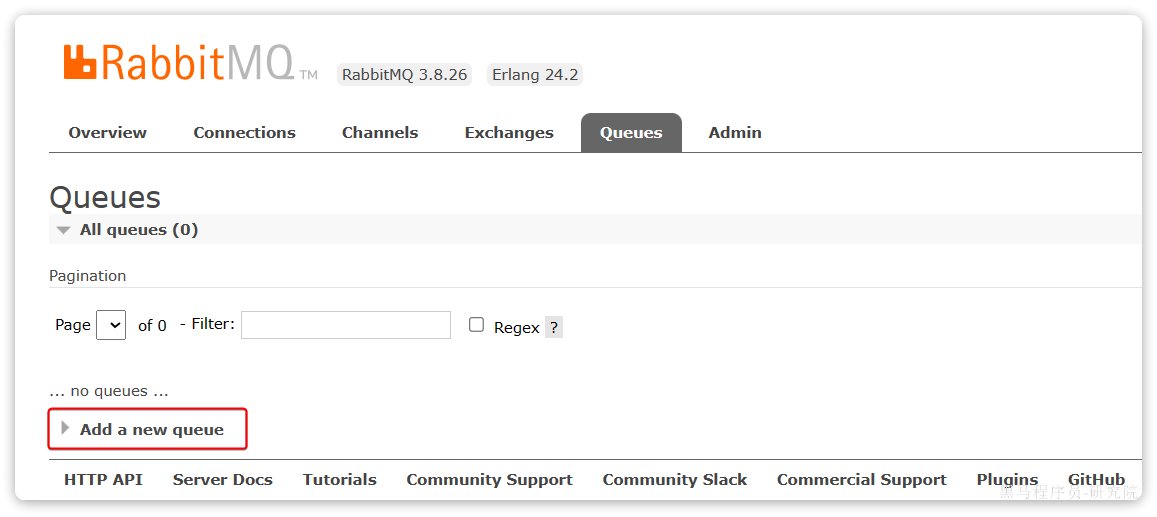
命名为hello.queue1:
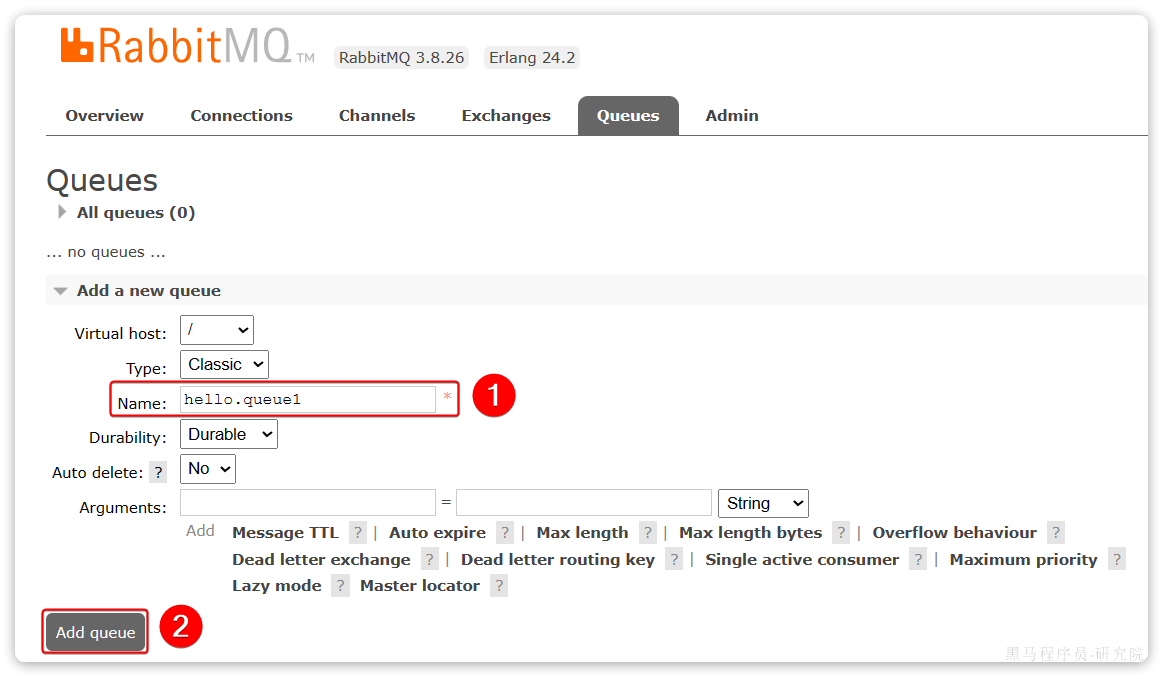
再以相同的方式,创建一个队列,密码为hello.queue2,最终队列列表如下:
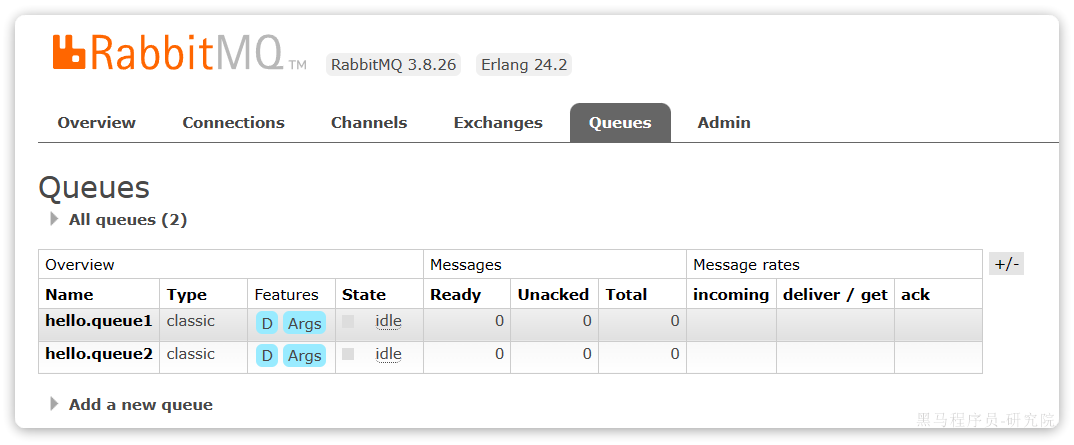
此时,我们再次向amq.fanout交换机发送一条消息。会发现消息依然没有到达队列!!
怎么回事呢?
发送到交换机的消息,只会路由到与其绑定的队列,因此仅仅创建队列是不够的,我们还需要将其与交换机绑定。
2.2.3.绑定关系
点击Exchanges选项卡,点击amq.fanout交换机,进入交换机详情页,然后点击Bindings菜单,在表单中填写要绑定的队列名称:

相同的方式,将hello.queue2也绑定到改交换机。
最终,绑定结果如下:
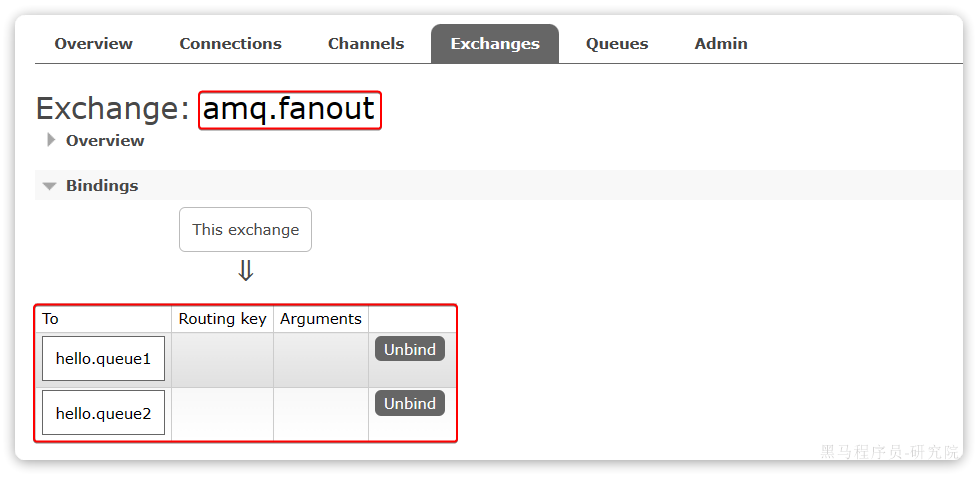
2.2.4.发送消息
再次回到exchange页面,找到刚刚绑定的amq.fanout,点击进入详情页,再次发送一条消息:

回到Queues页面,可以发现hello.queue中已经有一条消息了:
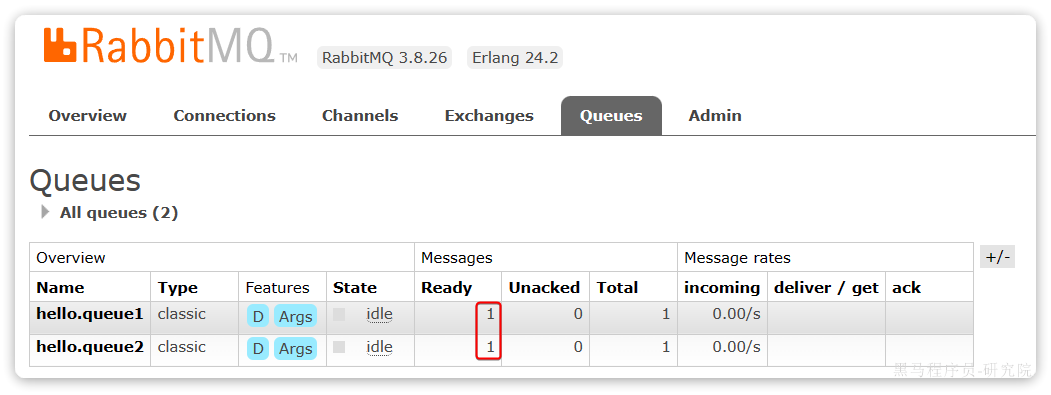
点击队列名称,进入详情页,查看队列详情,这次我们点击get message:
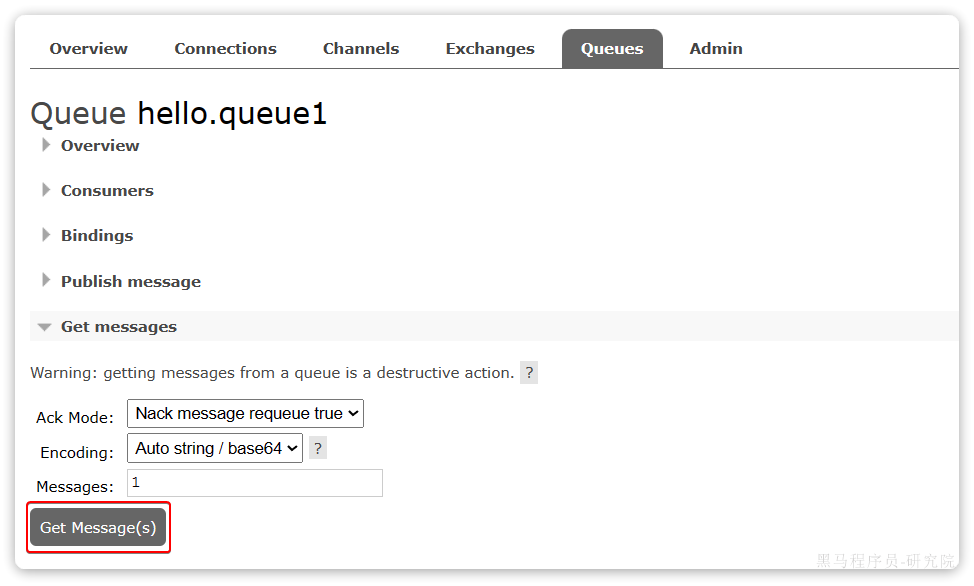
可以看到消息到达队列了:

这个时候如果有消费者监听了MQ的hello.queue1或hello.queue2队列,自然就能接收到消息了。
2.3.数据隔离
2.3.1.用户管理
点击Admin选项卡,首先会看到RabbitMQ控制台的用户管理界面:

这里的用户都是RabbitMQ的管理或运维人员。目前只有安装RabbitMQ时添加的liming这个用户。仔细观察用户表格中的字段,如下:
Name:liming,也就是用户名Tags:administrator,说明itheima用户是超级管理员,拥有所有权限Can access virtual host:/,可以访问的virtual host,这里的/是默认的virtual host
对于小型企业而言,出于成本考虑,我们通常只会搭建一套MQ集群,公司内的多个不同项目同时使用。这个时候为了避免互相干扰, 我们会利用virtual host的隔离特性,将不同项目隔离。一般会做两件事情:
- 给每个项目创建独立的运维账号,将管理权限分离。
- 给每个项目创建不同的
virtual host,将每个项目的数据隔离。
比如,我们给门店营运项目创建一个新的用户,命名为sod:

你会发现此时sod用户没有任何virtual host的访问权限:

别急,接下来我们就来授权。
2.3.2.virtual host(虚拟主机)
我们先退出登录:

切换到刚刚创建的sod用户登录,然后点击Virtual Hosts菜单,进入virtual host管理页:

可以看到目前只有一个默认的virtual host,名字为 /。
我们可以给门店营运诊断项目创建一个单独的virtual host,而不是使用默认的/。
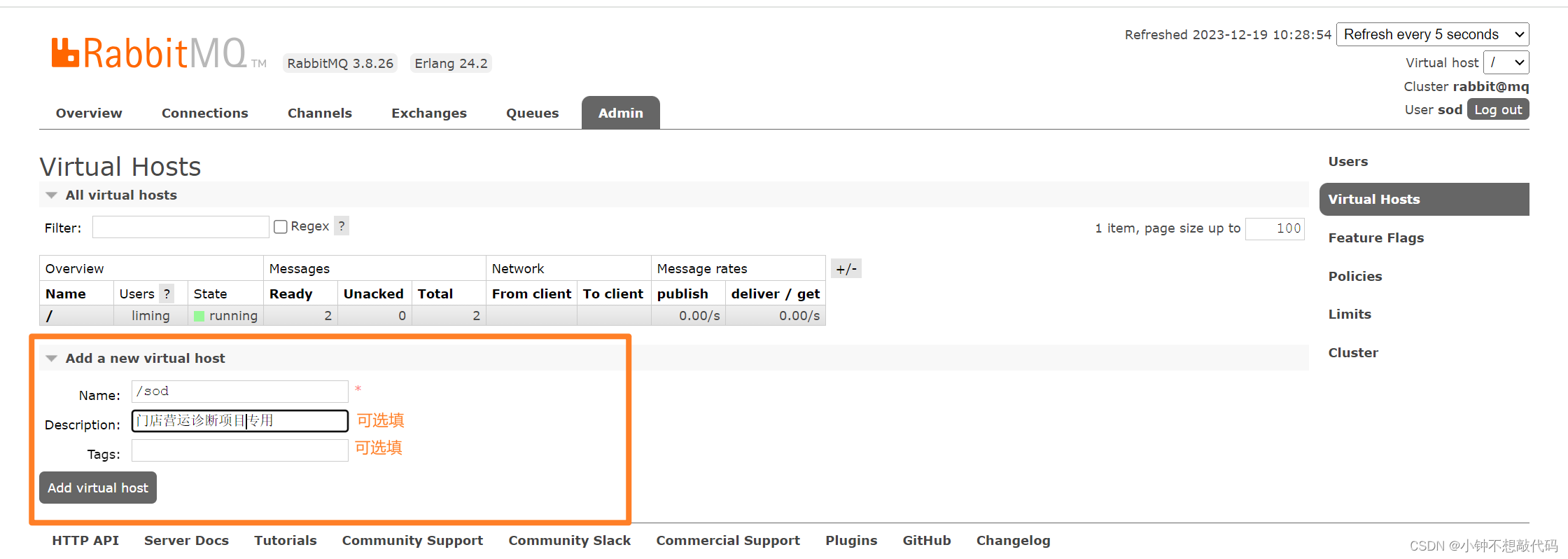
创建完成后如图:

由于我们是登录sod账户后创建的virtual host,因此回到users菜单,你会发现当前用户已经具备了对/sod这个virtual host的访问权限了:

此时,点击页面右上角的virtual host下拉菜单,切换virtual host为 /sod:
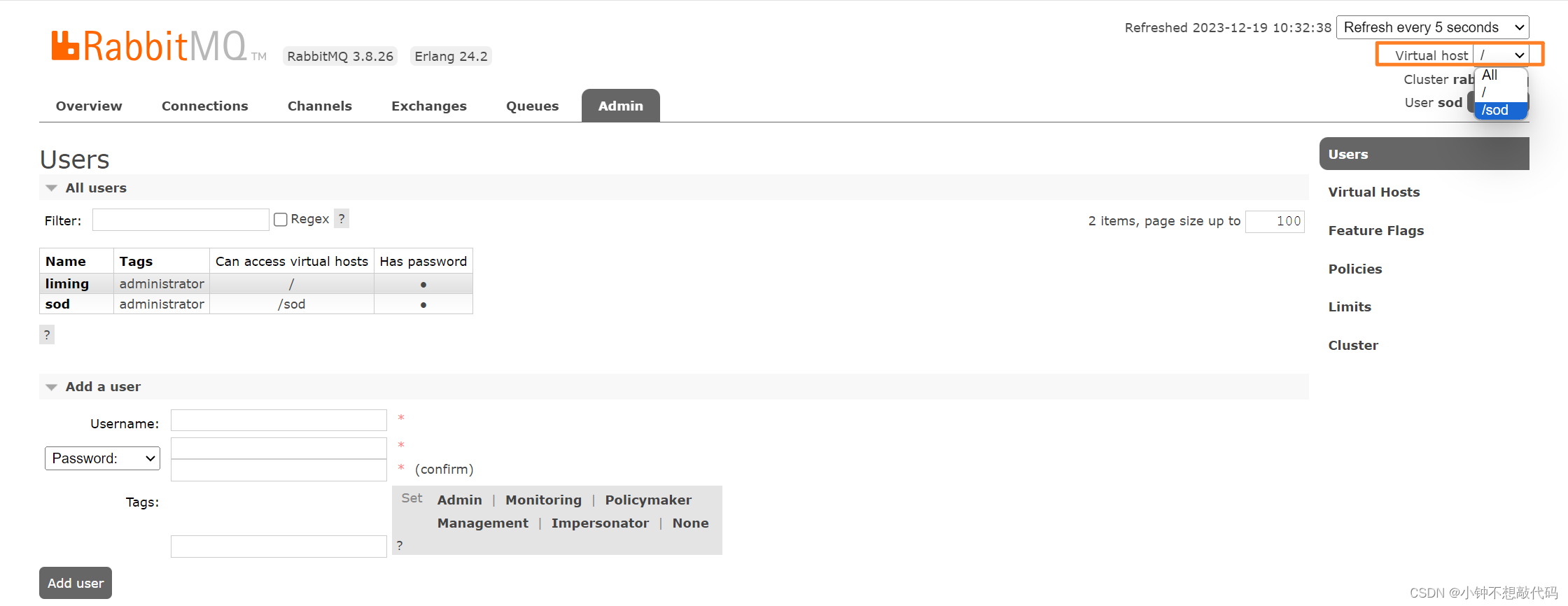
然后再次查看Queues选项卡,会发现之前的队列已经看不到了:

这就是基于virtual host 的隔离效果。
3.SpringAMQP
RabbitMQ使用AMQP协议,支持跨语言交互,官方提供了多种语言的客户端。在Java环境下,结合Spring框架使用Spring AMQP可以更加方便地进行消息收发,尤其是在生产环境中。Spring AMQP通过自动装配,与Spring Boot无缝集成,简化了RabbitMQ的使用。
SpringAmqp的官方地址:Spring AMQP
SpringAMQP提供了三个功能:
- 自动声明队列、交换机及其绑定关系
- 基于注解的监听器模式,异步接收消息
- 封装了RabbitTemplate工具,用于发送消息
3.1.编写Demo工程
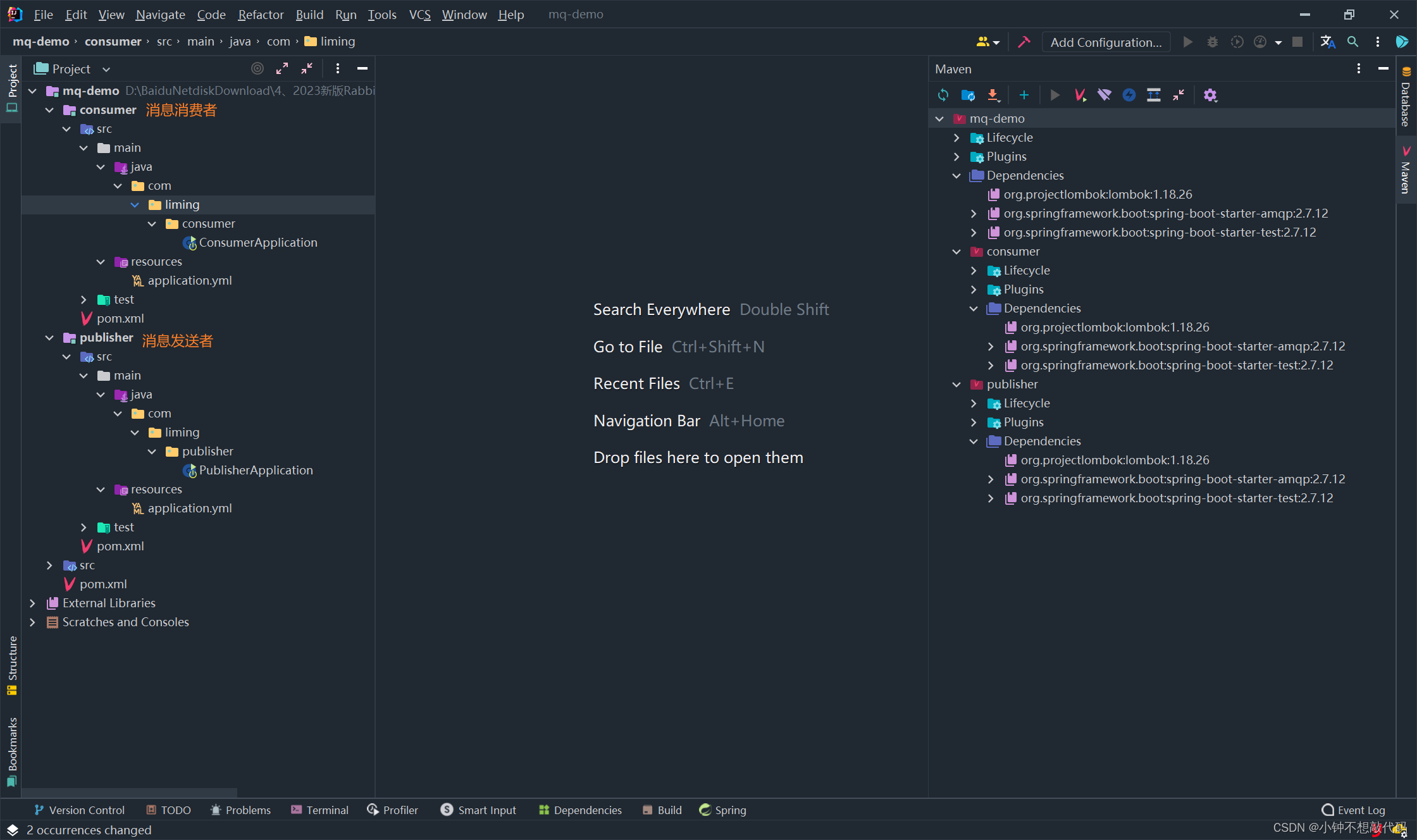
包括三部分:
- mq-demo:父工程,管理项目依赖
- publisher:消息的发送者
- consumer:消息的消费者
在mq-demo这个父工程中,已经配置好了SpringAMQP相关的依赖:
<?xml version="1.0" encoding="UTF-8"?>
<project xmlns="http://maven.apache.org/POM/4.0.0"
xmlns:xsi="http://www.w3.org/2001/XMLSchema-instance"
xsi:schemaLocation="http://maven.apache.org/POM/4.0.0 http://maven.apache.org/xsd/maven-4.0.0.xsd">
<modelVersion>4.0.0</modelVersion>
<groupId>cn.itcast.demo</groupId>
<artifactId>mq-demo</artifactId>
<version>1.0-SNAPSHOT</version>
<modules>
<module>publisher</module>
<module>consumer</module>
</modules>
<packaging>pom</packaging>
<parent>
<groupId>org.springframework.boot</groupId>
<artifactId>spring-boot-starter-parent</artifactId>
<version>2.7.12</version>
<relativePath/>
</parent>
<properties>
<maven.compiler.source>8</maven.compiler.source>
<maven.compiler.target>8</maven.compiler.target>
</properties>
<dependencies>
<dependency>
<groupId>org.projectlombok</groupId>
<artifactId>lombok</artifactId>
</dependency>
<!--AMQP依赖,包含RabbitMQ-->
<dependency>
<groupId>org.springframework.boot</groupId>
<artifactId>spring-boot-starter-amqp</artifactId>
</dependency>
<!--单元测试-->
<dependency>
<groupId>org.springframework.boot</groupId>
<artifactId>spring-boot-starter-test</artifactId>
</dependency>
</dependencies>
</project>
因此,子工程中就可以直接使用SpringAMQP了。
3.2.快速入门
在之前的案例中,我们都是经过交换机发送消息到队列,不过有时候为了测试方便,我们也可以直接向队列发送消息,跳过交换机。
在入门案例中,我们就演示这样的简单模型,如图:

也就是:
- publisher直接发送消息到队列
- 消费者监听并处理队列中的消息
注意:这种模式一般测试使用,很少在生产中使用。
为了方便测试,我们现在控制台新建一个队列:simple.queue

添加成功:
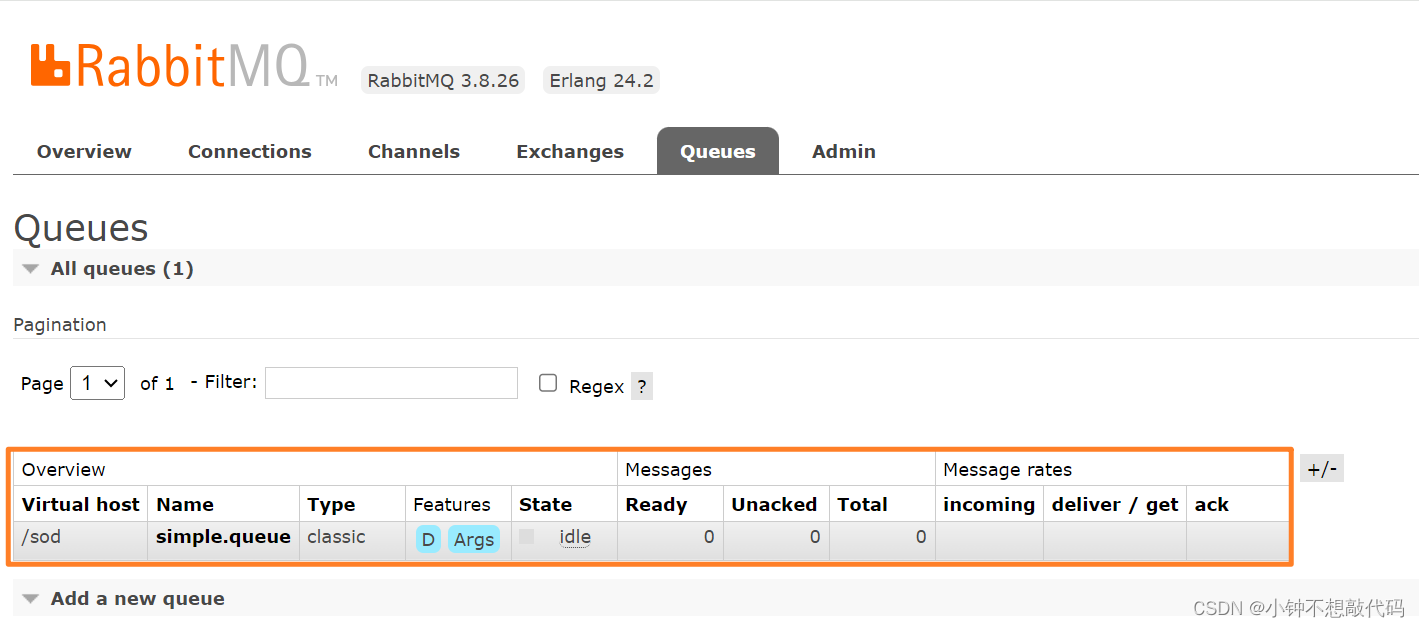
3.1.1.消息发送
首先配置MQ地址,在publisher服务的application.yml中添加配置:
spring:
rabbitmq:
host: 47.108.181.66 # 你的服务器IP
port: 5672 # 端口
virtual-host: /sod # 虚拟主机
username: sod # 用户名
password: 123 # 密码
然后在publisher服务中编写测试类SpringAmqpTest,并利用RabbitTemplate实现消息发送:
package com.liming.publisher.amqp;
import org.junit.jupiter.api.Test;
import org.springframework.amqp.rabbit.core.RabbitTemplate;
import org.springframework.beans.factory.annotation.Autowired;
import org.springframework.boot.test.context.SpringBootTest;
@SpringBootTest
public class SpringAmqpTest {
@Autowired
private RabbitTemplate rabbitTemplate;
@Test
public void testSimpleQueue() {
// 队列名称
String queueName = "simple.queue";
// 消息
String message = "hello, spring amqp!";
// 发送消息
rabbitTemplate.convertAndSend(queueName, message);
}
}
打开控制台,可以看到消息已经发送到队列中:

3.1.2.消息接收
首先配置MQ地址,在consumer服务的application.yml中添加配置:
spring:
rabbitmq:
host: 47.108.181.66 # 你的服务器IP
port: 5672 # 端口
virtual-host: /sod # 虚拟主机
username: sod # 用户名
password: 123 # 密码
然后在consumer服务的com.liming.consumer.listener包中新建一个类SpringRabbitListener,代码如下:
package com.liming.consumer.listener;
import org.springframework.amqp.rabbit.annotation.RabbitListener;
import org.springframework.stereotype.Component;
@Component
public class SpringRabbitListener {
// 利用RabbitListener来声明要监听的队列信息
// 将来一旦监听的队列中有了消息,就会推送给当前服务,调用当前方法,处理消息
@RabbitListener(queues = "simple.queue")
public void listenSimpleQueueMessage(String msg) throws InterruptedException {
System.out.println("spring 消费者接收到消息:【" + msg + "】");
}
}
3.1.3.测试
启动consumer服务,然后在publisher服务中运行测试代码,发送MQ消息。最终consumer收到消息:

3.3.WorkQueues模型
Work queues,任务模型。简单来说就是让多个消费者绑定到一个队列,共同消费队列中的消息。

当消息处理比较耗时的时候,可能生产消息的速度会远远大于消息的消费速度。长此以往,消息就会堆积越来越多,无法及时处理。此时就可以使用work 模型,多个消费者共同处理消息处理,消息处理的速度就能大大提高了。
首先,我们在控制台创建一个新的队列,命名为work.queue:

3.3.1.消息发送
这次我们循环发送,模拟大量消息堆积现象。在publisher服务中的SpringAmqpTest类中添加一个测试方法:
/**
* workQueue
* 向队列中不停发送消息,模拟消息堆积。
*/
@Test
public void testWorkQueue() throws InterruptedException {
// 队列名称
String queueName = "work.queue";
// 消息
String message = "hello, message_";
for (int i = 0; i < 50; i++) {
// 发送消息,每20毫秒发送一次,相当于每秒发送50条消息
rabbitTemplate.convertAndSend(queueName, message + i);
Thread.sleep(20);
}
}
3.3.2.消息接收
要模拟多个消费者绑定同一个队列,我们在consumer服务的SpringRabbitListener中添加2个新的方法:
@RabbitListener(queues = "work.queue")
public void listenWorkQueue1(String msg) throws InterruptedException {
System.out.println("消费者1接收到消息:【" + msg + "】" + LocalTime.now());
Thread.sleep(20);
}
@RabbitListener(queues = "work.queue")
public void listenWorkQueue2(String msg) throws InterruptedException {
System.err.println("消费者2........接收到消息:【" + msg + "】" + LocalTime.now());
Thread.sleep(200);
}
注意到这两消费者,都设置了Thead.sleep,模拟任务耗时:
- 消费者1 sleep了20毫秒,相当于每秒钟处理50个消息
- 消费者2 sleep了200毫秒,相当于每秒处理5个消息
3.3.3.测试
启动ConsumerApplication后,在执行publisher服务中刚刚编写的发送测试方法testWorkQueue。
最终结果如下:
消费者1接收到消息:【hello, message_0】11:24:35.347
消费者2接收到消息:【hello, message_1】11:24:35.363
消费者1接收到消息:【hello, message_2】11:24:35.394
消费者1接收到消息:【hello, message_4】11:24:35.457
消费者1接收到消息:【hello, message_6】11:24:35.523
消费者2接收到消息:【hello, message_3】11:24:35.567
消费者1接收到消息:【hello, message_8】11:24:35.598
消费者1接收到消息:【hello, message_10】11:24:35.645
消费者1接收到消息:【hello, message_12】11:24:35.708
消费者2接收到消息:【hello, message_5】11:24:35.771
消费者1接收到消息:【hello, message_14】11:24:35.771
消费者1接收到消息:【hello, message_16】11:24:35.834
消费者1接收到消息:【hello, message_18】11:24:35.896
消费者1接收到消息:【hello, message_20】11:24:35.960
消费者2接收到消息:【hello, message_7】11:24:35.975
消费者1接收到消息:【hello, message_22】11:24:36.024
消费者1接收到消息:【hello, message_24】11:24:36.085
消费者1接收到消息:【hello, message_26】11:24:36.148
消费者2接收到消息:【hello, message_9】11:24:36.179
消费者1接收到消息:【hello, message_28】11:24:36.210
消费者1接收到消息:【hello, message_30】11:24:36.273
消费者1接收到消息:【hello, message_32】11:24:36.336
消费者2接收到消息:【hello, message_11】11:24:36.383
消费者1接收到消息:【hello, message_34】11:24:36.399
消费者1接收到消息:【hello, message_36】11:24:36.462
消费者1接收到消息:【hello, message_38】11:24:36.525
消费者2接收到消息:【hello, message_13】11:24:36.587
消费者1接收到消息:【hello, message_40】11:24:36.587
消费者1接收到消息:【hello, message_42】11:24:36.651
消费者1接收到消息:【hello, message_44】11:24:36.713
消费者1接收到消息:【hello, message_46】11:24:36.776
消费者2接收到消息:【hello, message_15】11:24:36.792
消费者1接收到消息:【hello, message_48】11:24:36.839
消费者2接收到消息:【hello, message_17】11:24:36.996
消费者2接收到消息:【hello, message_19】11:24:37.204
消费者2接收到消息:【hello, message_21】11:24:37.408
消费者2接收到消息:【hello, message_23】11:24:37.612
消费者2接收到消息:【hello, message_25】11:24:37.816
消费者2接收到消息:【hello, message_27】11:24:38.020
消费者2接收到消息:【hello, message_29】11:24:38.224
消费者2接收到消息:【hello, message_31】11:24:38.429
消费者2接收到消息:【hello, message_33】11:24:38.633
消费者2接收到消息:【hello, message_35】11:24:38.837
消费者2接收到消息:【hello, message_37】11:24:39.041
消费者2接收到消息:【hello, message_39】11:24:39.245
消费者2接收到消息:【hello, message_41】11:24:39.449
消费者2接收到消息:【hello, message_43】11:24:39.654
消费者2接收到消息:【hello, message_45】11:24:39.858
消费者2接收到消息:【hello, message_47】11:24:40.062
消费者2接收到消息:【hello, message_49】11:24:40.267
可以看到消费者1和消费者2竟然每人消费了25条消息:
- 消费者1很快完成了自己的25条消息
- 消费者2却在缓慢的处理自己的25条消息。
也就是说消息是
平均分配给每个消费者,并没有考虑到消费者的处理能力。导致1个消费者空闲,另一个消费者忙的不可开交。没有充分利用每一个消费者的能力,最终消息处理的耗时远远超过了1秒。这样显然是有问题的。
3.3.4.能者多劳
在spring中有一个简单的配置,可以解决这个问题。我们修改consumer服务的application.yml文件,添加配置:
spring:
rabbitmq:
listener:
simple:
prefetch: 1 # 每次只能获取一条消息,处理完成才能获取下一个消息
再次测试,发现结果如下:
消费者2接收到消息:【hello, message_0】11:28:27.766
消费者1接收到消息:【hello, message_1】11:28:27.798
消费者1接收到消息:【hello, message_2】11:28:27.845
消费者1接收到消息:【hello, message_3】11:28:27.897
消费者1接收到消息:【hello, message_4】11:28:27.939
消费者1接收到消息:【hello, message_6】11:28:27.986
消费者2接收到消息:【hello, message_5】11:28:27.986
消费者1接收到消息:【hello, message_7】11:28:28.033
消费者1接收到消息:【hello, message_8】11:28:28.080
消费者1接收到消息:【hello, message_9】11:28:28.128
消费者1接收到消息:【hello, message_10】11:28:28.175
消费者2接收到消息:【hello, message_11】11:28:28.206
消费者1接收到消息:【hello, message_12】11:28:28.222
消费者1接收到消息:【hello, message_13】11:28:28.269
消费者1接收到消息:【hello, message_14】11:28:28.316
消费者1接收到消息:【hello, message_15】11:28:28.363
消费者1接收到消息:【hello, message_16】11:28:28.410
消费者2接收到消息:【hello, message_17】11:28:28.426
消费者1接收到消息:【hello, message_18】11:28:28.457
消费者1接收到消息:【hello, message_19】11:28:28.520
消费者1接收到消息:【hello, message_20】11:28:28.567
消费者1接收到消息:【hello, message_21】11:28:28.614
消费者2接收到消息:【hello, message_22】11:28:28.661
消费者1接收到消息:【hello, message_23】11:28:28.661
消费者1接收到消息:【hello, message_24】11:28:28.708
消费者1接收到消息:【hello, message_25】11:28:28.755
消费者1接收到消息:【hello, message_26】11:28:28.803
消费者1接收到消息:【hello, message_27】11:28:28.850
消费者2接收到消息:【hello, message_28】11:28:28.881
消费者1接收到消息:【hello, message_29】11:28:28.900
消费者1接收到消息:【hello, message_30】11:28:28.944
消费者1接收到消息:【hello, message_31】11:28:28.991
消费者1接收到消息:【hello, message_32】11:28:29.038
消费者1接收到消息:【hello, message_33】11:28:29.085
消费者2接收到消息:【hello, message_34】11:28:29.100
消费者1接收到消息:【hello, message_35】11:28:29.132
消费者1接收到消息:【hello, message_36】11:28:29.179
消费者1接收到消息:【hello, message_37】11:28:29.226
消费者1接收到消息:【hello, message_38】11:28:29.273
消费者2接收到消息:【hello, message_39】11:28:29.320
消费者1接收到消息:【hello, message_40】11:28:29.320
消费者1接收到消息:【hello, message_41】11:28:29.367
消费者1接收到消息:【hello, message_42】11:28:29.478
消费者1接收到消息:【hello, message_43】11:28:29.525
消费者2接收到消息:【hello, message_44】11:28:29.540
消费者1接收到消息:【hello, message_45】11:28:29.572
消费者1接收到消息:【hello, message_46】11:28:29.619
消费者1接收到消息:【hello, message_47】11:28:29.666
消费者1接收到消息:【hello, message_48】11:28:29.713
消费者2接收到消息:【hello, message_49】11:28:29.761
可以发现,由于消费者1处理速度较快,所以处理了更多的消息;消费者2处理速度较慢,只处理了6条消息。而最终总的执行耗时也在1秒左右,大大提升。
3.3.5.总结
Work模型的使用:
- 多个消费者绑定到一个队列,
同一条消息只会被一个消费者处理 - 通过设置
prefetch来控制消费者预取的消息数量
3.4.交换机类型
在之前的两个测试案例中,都没有
交换机,生产者直接发送消息到队列。而一旦引入交换机,消息发送的模式会有很大变化:

可以看到,在订阅模型中,多了一个exchange角色,而且过程略有变化:
- Publisher:生产者,不再发送消息到队列中,而是发给交换机
- Exchange:交换机,一方面,接收生产者发送的消息。另一方面,知道如何处理消息,例如递交给某个特别队列、递交给所有队列、或是将消息丢弃。到底如何操作,取决于Exchange的类型。
- Queue:消息队列也与以前一样,接收消息、缓存消息。不过队列一定要与交换机绑定。
- Consumer:消费者,与以前一样,订阅队列,没有变化
Exchange(交换机)只负责转发消息,不具备存储消息的能力,因此如果没有任何队列与Exchange绑定,或者没有符合路由规则的队列,那么消息会丢失!
交换机的类型有四种:
- Fanout:广播,将消息交给所有绑定到交换机的队列。我们最早在控制台使用的正是Fanout交换机
- Direct:订阅,基于RoutingKey(路由key)发送给订阅了消息的队列
- Topic:通配符订阅,与Direct类似,只不过RoutingKey可以使用通配符
- Headers:头匹配,基于MQ的消息头匹配,用的较少。
3.5.Fanout交换机
Fanout,英文翻译是扇出,我觉得在MQ中叫
广播更合适。在广播模式下,消息发送流程是这样的:

- 1) 可以有
多个队列 - 2) 每个队列都要绑定到
Exchange(交换机) - 3) 生产者发送的消息,只能发送到
交换机 - 4) 交换机把消息发送给绑定过的所有
队列 - 5) 订阅队列的消费者都能拿到消息
3.5.1.声明队列和交换机
在控制台创建队列fanout.queue1和fanout.queue2:
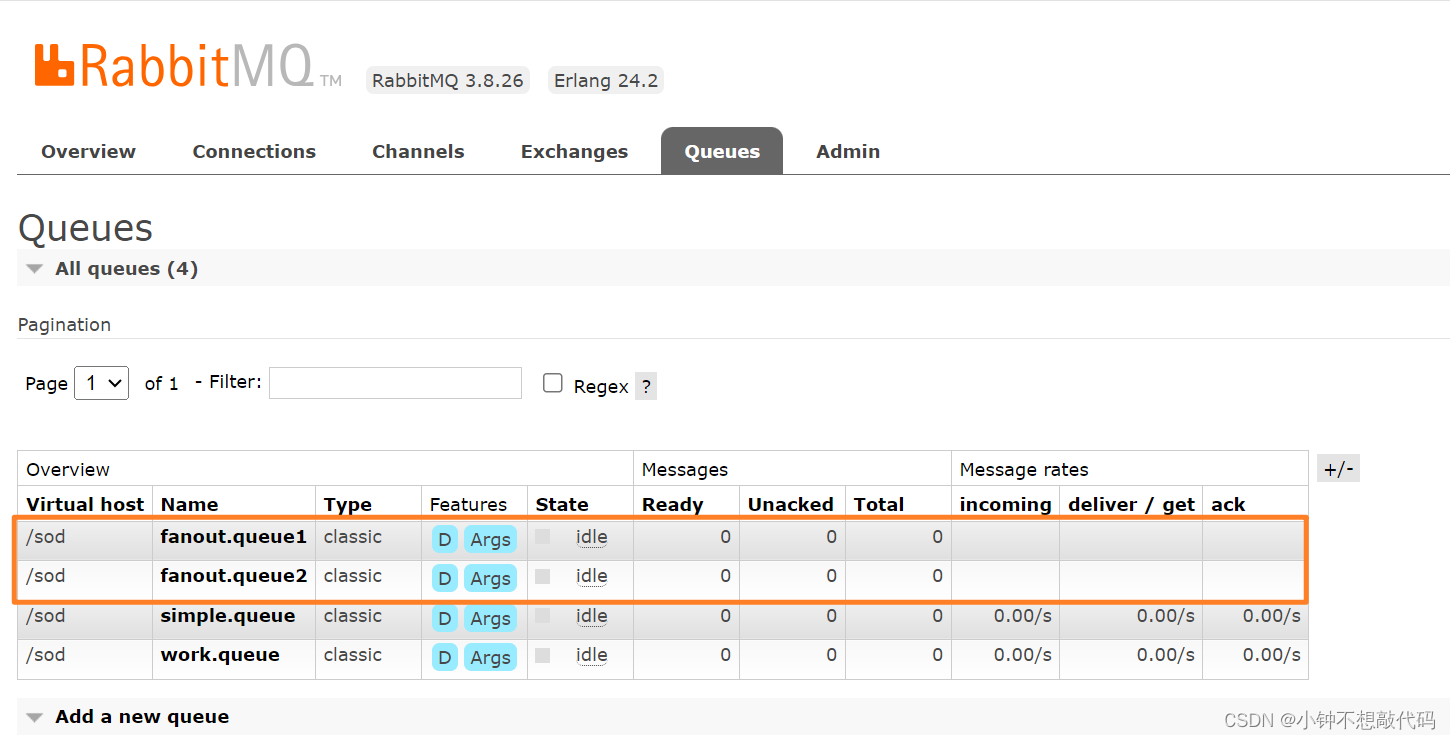
然后再创建一个交换机:

然后绑定两个队列到交换机:
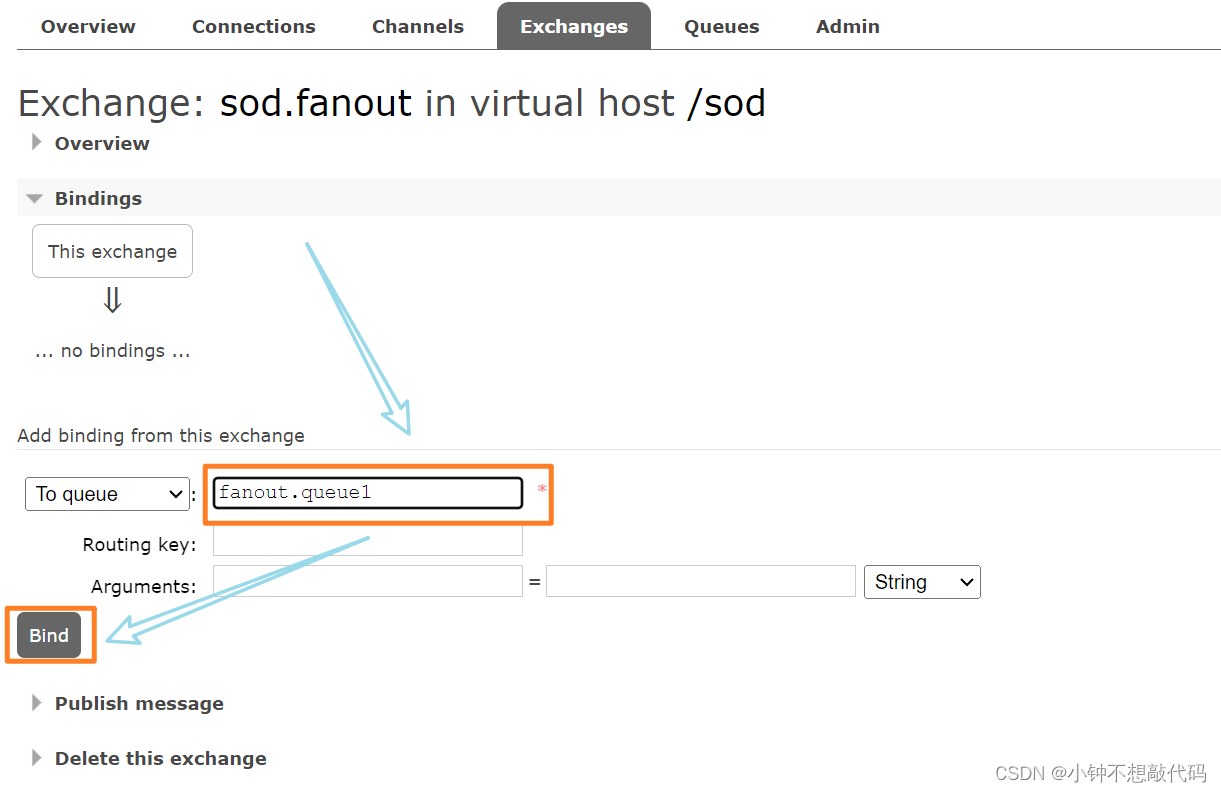
3.5.2.消息发送
在publisher服务的SpringAmqpTest类中添加测试方法:
@Test
public void testFanoutExchange() {
// 交换机名称
String exchangeName = "sod.fanout";
// 消息
String message = "hello, everyone!";
rabbitTemplate.convertAndSend(exchangeName, "", message);
}
3.5.3.消息接收
在consumer服务的SpringRabbitListener中添加两个方法,作为消费者:
@RabbitListener(queues = "fanout.queue1")
public void listenFanoutQueue1(String msg) {
System.out.println("消费者1接收到Fanout消息:【" + msg + "】");
}
@RabbitListener(queues = "fanout.queue2")
public void listenFanoutQueue2(String msg) {
System.out.println("消费者2接收到Fanout消息:【" + msg + "】");
}

3.5.4.总结
交换机的作用是什么?
- 接收
publisher发送的消息 - 将消息按照规则路由到与之绑定的队列
- 不能缓存消息,路由失败,消息丢失
- FanoutExchange的会将消息路由到每个绑定的队列
3.6.Direct交换机
在Fanout模式中,一条消息,会被所有订阅的队列都消费。但是,在某些场景下,我们希望不同的消息被不同的队列消费。这时就要用到Direct类型的Exchange。

在Direct模型下:
- 队列与交换机的绑定,不能是任意绑定了,而是要指定一个
RoutingKey(路由key) - 消息的发送方在 向 Exchange发送消息时,也必须指定消息的
RoutingKey。 - Exchange不再把消息交给每一个绑定的队列,而是根据消息的
Routing Key进行判断,只有队列的Routingkey与消息的Routing key完全一致,才会接收到消息
3.6.1.声明队列和交换机
首先在控制台声明两个队列direct.queue1和direct.queue2:

然后声明一个direct类型的交换机,命名为sod.direct:
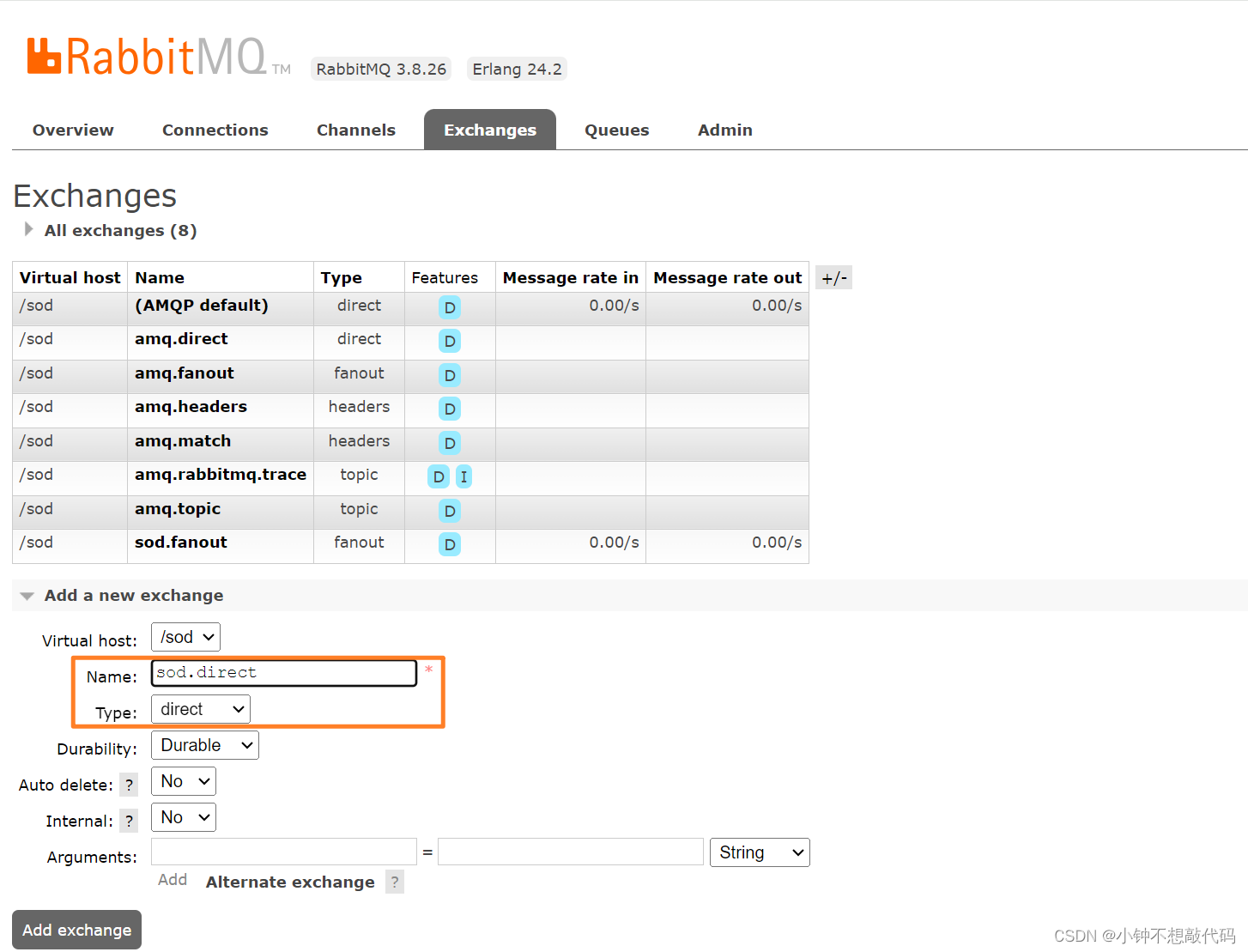
然后使用red和blue作为key,绑定direct.queue1和direct.queue2到sod.direct:

3.6.2.消息接收
在consumer服务的SpringRabbitListener中添加方法:
@RabbitListener(queues = "direct.queue1")
public void listenDirectQueue1(String msg) {
System.out.println("消费者1接收到direct.queue1的消息:【" + msg + "】");
}
@RabbitListener(queues = "direct.queue2")
public void listenDirectQueue2(String msg) {
System.out.println("消费者2接收到direct.queue2的消息:【" + msg + "】");
}
3.6.3.消息发送
在publisher服务的SpringAmqpTest类中添加测试方法:
@Test
public void testSendDirectExchange() {
// 交换机名称
String exchangeName = "sod.direct";
// 消息
String message = "红色警报!日本乱排核废水,导致海洋生物变异,惊现哥斯拉!";
// 发送消息
rabbitTemplate.convertAndSend(exchangeName, "red", message);
}
由于使用的red这个key,所以两个消费者都收到了消息:

我们再切换为blue这个key:
@Test
public void testSendDirectExchange() {
// 交换机名称
String exchangeName = "sod.direct";
// 消息
String message = "最新报道,哥斯拉是居民自治巨型气球,虚惊一场!";
// 发送消息
rabbitTemplate.convertAndSend(exchangeName, "blue", message);
}

3.6.4.总结
描述下Direct交换机与Fanout交换机的差异?
- Fanout交换机将消息路由给每一个与之绑定的队列
- Direct交换机根据
RoutingKey判断路由给哪个队列 - 如果多个队列具有相同的RoutingKey,则与Fanout功能类似
3.7.Topic交换机
3.7.1.说明
Topic类型的Exchange与Direct相比,都是可以根据RoutingKey把消息路由到不同的队列。
只不过Topic类型Exchange可以让队列在绑定BindingKey的时候使用通配符!
BindingKey 一般都是有一个或多个单词组成,多个单词之间以.分割,例如: item.insert
通配符规则:
#:匹配一个或多个词*:匹配不多不少恰好1个词
举例:
item.#:能够匹配item.spu.insert或者item.spuitem.*:只能匹配item.spu
图示:

假如此时publisher发送的消息使用的RoutingKey共有四种:
china.news代表有中国的新闻消息;china.weather代表中国的天气消息;japan.news则代表日本新闻japan.weather代表日本的天气消息;
解释:
topic.queue1:绑定的是china.#,凡是以china.开头的routing key都会被匹配到,包括:china.newschina.weather
topic.queue2:绑定的是#.news,凡是以.news结尾的routing key都会被匹配。包括:china.newsjapan.news
首先,在控制台按照图示例子创建队列、交换机,并利用通配符绑定队列和交换机。此处步骤略。最终结果如下:
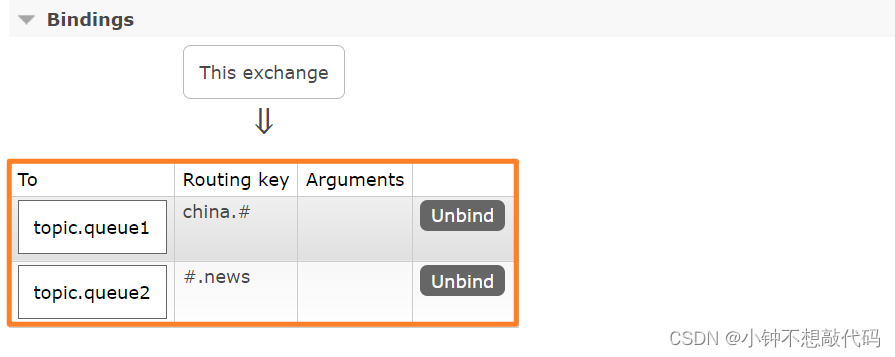
3.7.2.消息发送
在publisher服务的SpringAmqpTest类中添加测试方法:
/**
* topicExchange
*/
@Test
public void testSendTopicExchange() {
// 交换机名称
String exchangeName = "sod.topic";
// 消息
String message = "喜报!孙悟空大战哥斯拉,胜!";
// 发送消息
rabbitTemplate.convertAndSend(exchangeName, "china.news", message);
}
3.7.3.消息接收
在consumer服务的SpringRabbitListener中添加方法:
@RabbitListener(queues = "topic.queue1")
public void listenTopicQueue1(String msg){
System.out.println("消费者1接收到topic.queue1的消息:【" + msg + "】");
}
@RabbitListener(queues = "topic.queue2")
public void listenTopicQueue2(String msg){
System.out.println("消费者2接收到topic.queue2的消息:【" + msg + "】");
}

3.7.4.总结
描述下Direct交换机与Topic交换机的差异?
- Topic交换机接收的消息
RoutingKey必须是多个单词,以.分割 - Topic交换机与队列绑定时的bindingKey可以指定通配符
#:代表0个或多个词*:代表1个词
3.8.声明队列和交换机
在之前我们都是基于
RabbitMQ控制台来创建队列、交换机。但是在实际开发时,队列和交换机是程序员定义的,将来项目上线,又要交给运维去创建。因此推荐的做法是由程序启动时检查队列和交换机是否存在,如果不存在自动创建。
3.8.1.基本API
SpringAMQP提供了一个Queue类,用来创建队列:

SpringAMQP还提供了一个Exchange接口,来表示所有不同类型的交换机:

我们可以自己创建队列和交换机,不过SpringAMQP还提供了ExchangeBuilder来简化这个过程:

而在绑定队列和交换机时,则需要使用BindingBuilder来创建Binding对象:

3.8.2.fanout示例
在consumer中创建一个类,声明队列和交换机:
package com.liming.consumer.config;
import org.springframework.amqp.core.Binding;
import org.springframework.amqp.core.BindingBuilder;
import org.springframework.amqp.core.FanoutExchange;
import org.springframework.amqp.core.Queue;
import org.springframework.context.annotation.Bean;
import org.springframework.context.annotation.Configuration;
@Configuration
public class FanoutConfig {
/**
* 声明交换机
* @return Fanout类型交换机
*/
@Bean
public FanoutExchange fanoutExchange(){
return new FanoutExchange("sod.fanout");
}
/**
* 第1个队列
*/
@Bean
public Queue fanoutQueue1(){
return new Queue("fanout.queue1");
}
/**
* 绑定队列和交换机
*/
@Bean
public Binding bindingQueue1(Queue fanoutQueue1, FanoutExchange fanoutExchange){
return BindingBuilder.bind(fanoutQueue1).to(fanoutExchange);
}
/**
* 第2个队列
*/
@Bean
public Queue fanoutQueue2(){
return new Queue("fanout.queue2");
}
/**
* 绑定队列和交换机
*/
@Bean
public Binding bindingQueue2(Queue fanoutQueue2, FanoutExchange fanoutExchange){
return BindingBuilder.bind(fanoutQueue2).to(fanoutExchange);
}
}
3.8.2.direct示例
direct模式由于要绑定多个
KEY,会非常麻烦,每一个Key都要编写一个binding:
package com.liming.consumer.config;
import org.springframework.amqp.core.*;
import org.springframework.context.annotation.Bean;
import org.springframework.context.annotation.Configuration;
@Configuration
public class DirectConfig {
/**
* 声明交换机
* @return Direct类型交换机
*/
@Bean
public DirectExchange directExchange(){
return ExchangeBuilder.directExchange("sod.direct").build();
}
/**
* 第1个队列
*/
@Bean
public Queue directQueue1(){
return new Queue("direct.queue1");
}
/**
* 绑定队列和交换机
*/
@Bean
public Binding bindingQueue1WithRed(Queue directQueue1, DirectExchange directExchange){
return BindingBuilder.bind(directQueue1).to(directExchange).with("red");
}
/**
* 绑定队列和交换机
*/
@Bean
public Binding bindingQueue1WithBlue(Queue directQueue1, DirectExchange directExchange){
return BindingBuilder.bind(directQueue1).to(directExchange).with("blue");
}
/**
* 第2个队列
*/
@Bean
public Queue directQueue2(){
return new Queue("direct.queue2");
}
/**
* 绑定队列和交换机
*/
@Bean
public Binding bindingQueue2WithRed(Queue directQueue2, DirectExchange directExchange){
return BindingBuilder.bind(directQueue2).to(directExchange).with("red");
}
/**
* 绑定队列和交换机
*/
@Bean
public Binding bindingQueue2WithYellow(Queue directQueue2, DirectExchange directExchange){
return BindingBuilder.bind(directQueue2).to(directExchange).with("yellow");
}
}
3.8.4.基于注解声明(推荐)
基于@Bean的方式声明队列和交换机比较麻烦,Spring还提供了基于
注解方式来声明。
例如,我们同样声明Direct模式的交换机和队列:
@RabbitListener(bindings = @QueueBinding(
value = @Queue(name = "direct.queue1"),
exchange = @Exchange(name = "sod.direct", type = ExchangeTypes.DIRECT),
key = {"red", "blue"}
))
public void listenDirectQueue1(String msg){
System.out.println("消费者1接收到direct.queue1的消息:【" + msg + "】");
}
@RabbitListener(bindings = @QueueBinding(
value = @Queue(name = "direct.queue2"),
exchange = @Exchange(name = "sod.direct", type = ExchangeTypes.DIRECT),
key = {"red", "yellow"}
))
public void listenDirectQueue2(String msg){
System.out.println("消费者2接收到direct.queue2的消息:【" + msg + "】");
}
再试试Topic模式:
@RabbitListener(bindings = @QueueBinding(
value = @Queue(name = "topic.queue1"),
exchange = @Exchange(name = "sod.topic", type = ExchangeTypes.TOPIC),
key = "china.#"
))
public void listenTopicQueue1(String msg){
System.out.println("消费者1接收到topic.queue1的消息:【" + msg + "】");
}
@RabbitListener(bindings = @QueueBinding(
value = @Queue(name = "topic.queue2"),
exchange = @Exchange(name = "sod.topic", type = ExchangeTypes.TOPIC),
key = "#.news"
))
public void listenTopicQueue2(String msg){
System.out.println("消费者2接收到topic.queue2的消息:【" + msg + "】");
}
3.9.消息转换器
Spring的消息发送代码接收的消息体是一个Object:

而在数据传输时,它会把你发送的消息序列化为
字节发送给MQ,接收消息的时候,还会把字节反序列化为Java对象。只不过,默认情况下Spring采用的序列化方式是JDK序列化。
众所周知,JDK序列化存在下列问题:
- 数据体积过大
- 有安全漏洞
- 可读性差
3.9.1.测试默认转换器
- 创建测试队列
首先,我们在consumer服务中声明一个新的配置类,利用@Bean的方式创建一个队列

具体代码:
package com.liming.consumer.config;
import org.springframework.amqp.core.Queue;
import org.springframework.context.annotation.Bean;
import org.springframework.context.annotation.Configuration;
@Configuration
public class MessageConfig {
@Bean
public Queue objectQueue() {
return new Queue("object.queue");
}
}
重启consumer服务以后,该队列就会被自动创建出来了:

- 发送消息
我们在publisher模块的SpringAmqpTest中新增一个消息发送的代码,发送一个Map对象:
@Test
public void testSendMap() throws InterruptedException {
// 准备消息
Map<String,Object> msg = new HashMap<>();
msg.put("name", "柳岩");
msg.put("age", 21);
// 发送消息
rabbitTemplate.convertAndSend("object.queue", msg);
}
发送消息后查看控制台:
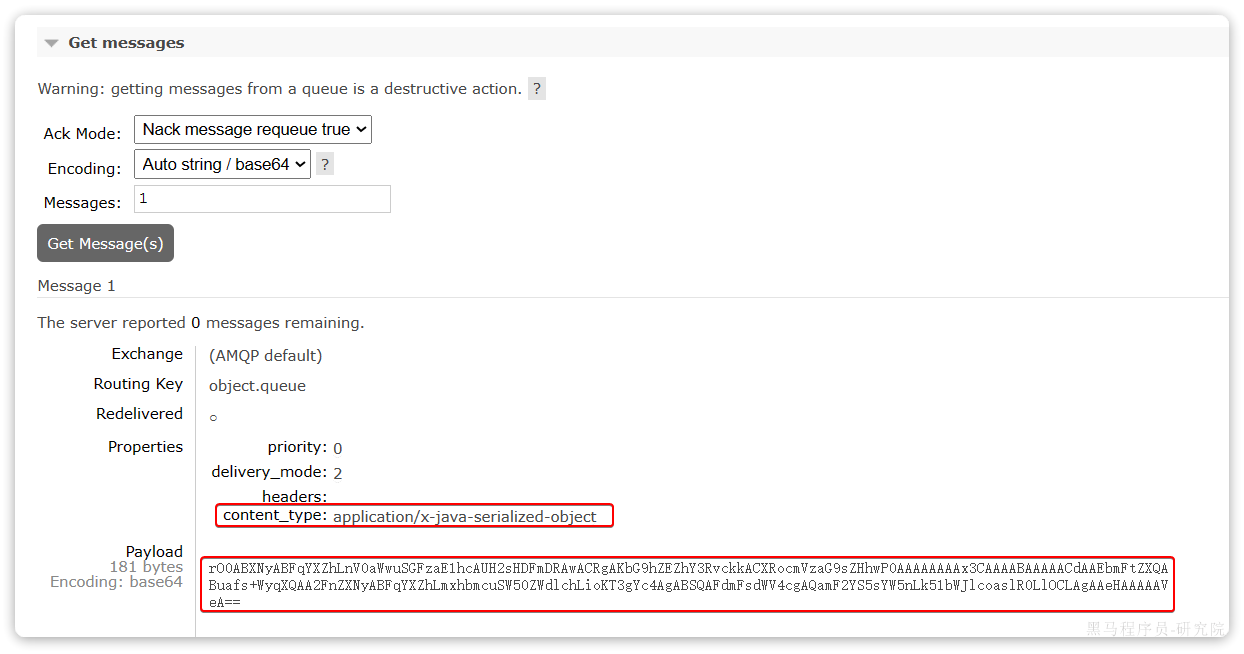
可以看到消息格式非常不友好。
3.9.2.配置JSON转换器
显然,JDK序列化方式并不合适。我们希望消息体的体积更小、可读性更高,因此可以使用
JSON方式来做序列化和反序列化。
在publisher和consumer两个服务中都引入依赖:
<dependency>
<groupId>com.fasterxml.jackson.dataformat</groupId>
<artifactId>jackson-dataformat-xml</artifactId>
<version>2.9.10</version>
</dependency>
注意,如果项目中引入了spring-boot-starter-web依赖,则无需再次引入Jackson依赖
配置消息转换器,在
publisher和consumer两个服务的启动类中添加一个Bean即可:
@Bean
public MessageConverter messageConverter(){
// 1.定义消息转换器
Jackson2JsonMessageConverter jackson2JsonMessageConverter = new Jackson2JsonMessageConverter();
// 2.配置自动创建消息id,用于识别不同消息,也可以在业务中基于ID判断是否是重复消息
jackson2JsonMessageConverter.setCreateMessageIds(true);
return jackson2JsonMessageConverter;
}
消息转换器中添加的messageId可以便于我们将来做幂等性判断。
此时,我们到MQ控制台删除object.queue中的旧的消息。然后再次执行刚才的消息发送的代码,到MQ的控制台查看消息结构:

3.9.3.消费者接收Object
我们在consumer服务中定义一个新的消费者,publisher是用Map发送,那么消费者也一定要用Map接收,格式如下:
@RabbitListener(queues = "object.queue")
public void listenSimpleQueueMessage(Map<String, Object> msg) throws InterruptedException {
System.out.println("消费者接收到object.queue消息:【" + msg + "】");
}

























 1183
1183











 被折叠的 条评论
为什么被折叠?
被折叠的 条评论
为什么被折叠?










